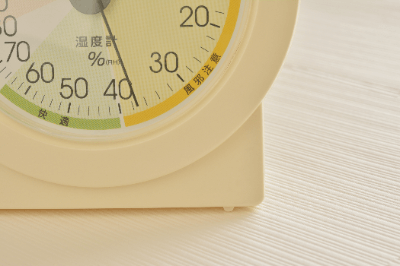What Is a Hygrometer?
 A hygrometer is a device that measures and displays the humidity in the air.
A hygrometer is a device that measures and displays the humidity in the air.
There are several indicators of humidity, but the one we use every day is relative humidity (%RH). Relative humidity is the ratio of the amount of water vapor in the air being measured to the maximum amount of water vapor the air can contain at that temperature.
Other parameters besides relative humidity include mixing ratio (kg/kg), absolute humidity (g/m^3), water vapor pressure (Pa), dew point temperature (°C), and mole fraction (mol/mol).
Hygrometers are broadly classified into analog and digital types. Analog hygrometers include dry hygrometers, hair hygrometers, and bimetallic hygrometers, which have been in use since around 1500. Basically, they do not use electricity. They are prone to errors and require maintenance and measurement conditions.
Digital electronic hygrometers are semiconductor-based sensors that are often combined with a temperature sensor to make a temperature/hygrometer. They are used for industrial applications because of their small size and easy data recording.
Uses of Hygrometers
Hygrometers have long been used in public weather observation and other applications. Hair hygrometers are used in museums and art galleries because they do not require electricity.
Industrial hygrometers are used in places where humidity is sensitive, such as in the cultivation of plastic greenhouses and mushrooms in agriculture, and in medical and pharmaceutical plants.
Recently, hygrometers are often used to prevent heat stroke. They are deployed in large gymnasiums, classrooms, nursing homes, and other indoor places where people are active. They are also installed in air conditioners and humidifiers and are responsible for automatic control of the equipment.
Principles of Hygrometers
Various principles are used to measure humidity. First of all, there are two main types of principles, depending on whether they are analog or digital.
1. Analog Type Hygrometer
Analog hygrometers are often used in daily-use hygrometers.
Wet and Dry Spherical Hygrometer
The wet and dry spherical hygrometer consists of two glass thermometers side by side, one of which is wrapped with gauze containing water. The gauze absorbs the moisture in the container and evaporates at the wrapped thermometer.
As the water evaporates, the heat of vaporization is lost, so the thermometer with the gauze wrapped around it displays a lower temperature (wet-bulb temperature). This temperature difference is used to calculate humidity. Some products have a wet-bulb temperature conversion chart between the two thermometers, so that the humidity can be read from the difference between the temperature of the thermometer without the gauze (dry-bulb temperature) and the wet-bulb temperature.
If the two thermometers have the same number, the wet cloth is not dry and no vaporization heat is generated, which means 100% humidity.
Hair Hygrometer
The hair hygrometer uses the elasticity of nylon threads and human hair to move the needle. The needle is enlarged using the principle of leverage, and the movement is recorded on a roll of paper.
Since measurements are made without the use of electricity, there is no risk of fire, so these gauges are used in museums.
Bimetal Hygrometer
The bimetal type Hygrometer uses a metal spring as the base, to which is laminated a dry chemical with different shrinkage rates that easily absorbs moisture, and the shape of the spring changes according to the humidity. This type of hygrometer is used in wall-mounted pointer-type hygrometers.
2. Digital Hygrometer
Digital hygrometers are widely used in industrial applications.
Electric resistance type
The electrical resistance type uses a humidity element whose electrical resistance changes according to the relative humidity. 20%RH or lower humidity is impossible to measure due to a large error, and the element deteriorates due to high temperature.
Capacitance type
The capacitance type uses the change in electrical capacitance stored in a capacitor. The amount of moisture adsorbed or released by the polymer film inside the capacitor is proportional to the relative humidity in the air. Unlike the electrical resistance type, it can measure from 0% relative humidity.
Dew-point Hygrometer (Optical)
The dew point is measured by shining the air to be measured onto a chilled mirror and detecting the fogging of the mirror from the reflection of light. The dew point temperature is the temperature at which the mirror begins to fog up. In addition, the relative humidity can be calculated separately from the air temperature. This is currently the most accurate method of measuring humidity.
Other Information on Hygrometers
Points to Note About Humidity Measurement
It is important to note that different types of hygrometers have different error ranges. Accuracy is important for measurement, but ease of measurement is also essential. For daily life, ease is more important than accuracy, and for industrial use, it is necessary to select a measurement method with an error range that can meet the objective.
Therefore, when selecting a hygrometer, be sure to check the possible measurement range and error range thoroughly.